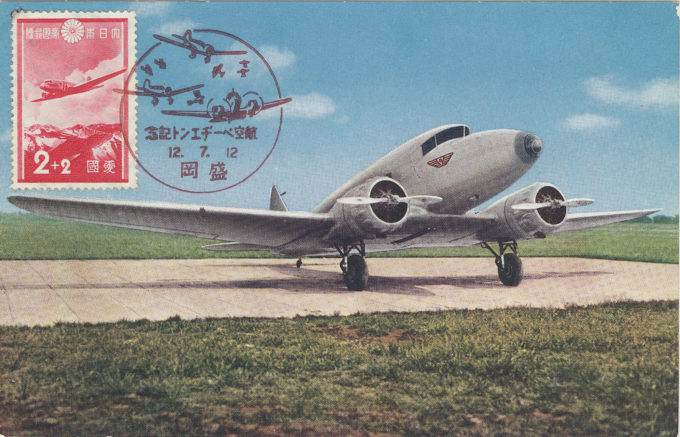
Nakajima AT-2 (Ki 34), 1937. The postcard is stamped to commemorate a July 1937 “air pageant”. The Nakajima Aircraft Company, which had acquired the license-production rights to the American-made Douglas DC-2, began design work of their own in 1935 building a smaller twin-engine airliner for routes which did not have the capacity to justify use of the larger DC-2. The initial design was designated AT-1. After numerous design iterations, a prototype designated AT-2 first flew on 12 September 1936. The aircraft design was all metal except for the flight control surfaces, which were made of plywood.
See also:
Nakajima Ki-27, “Nate”, 1936-1945.
Nakajima E8N, “Dave”, c. 1935-45.
Japan Air Transport Co. Hinazuru-type Airspeed As.6 Envoy, 1936.
“Nakajima Aircraft Co. in 1934 acquired from Douglas Aircraft (USA) licensed-construction rights for the DC-2 civil transport. While building licensed DC-2s, Nakajima designed a similar, smaller twin-engine light transport in 1935 that was based on the DC-2 (avoiding a lawsuit with Douglas by partially adopting the outer wing design of Northrop’s 2E) that Nakajima designated AT-1. It was not built, but further designs resulted in an improved transport – the AT-2 – powered by two Nakajima Kotobuki radial engines. Accommodation was provided for a crew of three plus eight passengers in an enclosed cabin. The first AT-2 prototype was flown on 12 September 1936.
“The AT-2 was placed in production for civil use. A total of 32 AT-2s were delivered between 1937 and 1940 to Dai Nippon Koku K.K. (Greater Japan Airlines Company) and Manchurian Airlines for use on internal and external routes.
“In 1937 the Koku hombu (Japanese army air headquarters) was anxious to introduce a modern transport aircraft into their air force inventory and turned to the AT-2, already established as an efficient aircraft. Designated Ki-34, deliveries began the same year and it immediately went into service as the Army Type 97 transport. After producing 19 of the aircraft, Nakajima turned over production to the Tachikawa Aircraft Co. (majority-owned by the army) which built a further 299 transports through 1942.
“At some later date, a number of AT-2 aircraft were transferred to the Imperial Japanese Navy, where they were known as the Navy Type AT-2 Transport or Nakajima L1N1. Several were also transferred to the air force of the Japanese puppet state of China-Nanjing in 1942.
“Both civil and military versions were allocated the Allied codename ‘Thora’, and were in use throughout the Pacific War.”
– Wikipedia
Performance data
Max. speed: 360 km/h / 224 mph
Ceiling: 7000 m / 22950 ft
Range w/max.fuel: 1200 km / 746 miles
Crew: 3
Passengers: 8

